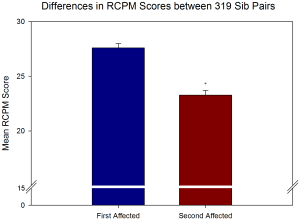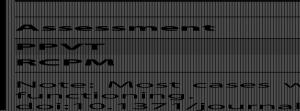By Matt Carey
A 2011 study in Pediatrics suggested that autism risk might be higher for siblings born within a few years of an older sibling, with the risk falling as the spacing between pregnancies increased (Closely spaced pregnancies are associated with increased odds of autism in California sibling births). This suggests prenatal environment would be involved in such a risk factor. In a study published on November 30, 2012 in PLoS One, researchers look at the characteristics of autistics born after a first sibling with autism. They look at measures of intelligence (both verbal and nonverbal), repetitive behaviors and social response. In The effects of birth order and birth interval on the phenotypic expression of autism spectrum disorder, researchers found that younger autistic siblings scored lower on these scales than their older autistic siblings. In other words, the challenges associated with autism tend to be higher for autistic younger siblings.
While the sample size for families with three autistic siblings was small, the trend seems to continue with a third sibling.
Here are results for the Ravens Colored Progressive Matrices, a test of nonverbal intelligence:

The fraction of individuals who the researchers deemed “untestable” increased for younger siblings. Where about 20% of first autistic siblings were “untestable”, this increased to about 40% for second and third autistic siblings.

Measures of motor skills (Vineland) were mostly the same for older and younger autistic siblings. Social measures (Social Responsiveness Scale) differed, but only when the age difference was under 2 years.
The authors give some discussion to what factors might be involved in these findings. While they acknowledge that social factors cannot be ruled out, this study, and the pediatrics paper before it, point to the prenatal environment as a possible avenue for environmental risk factor research.
Papers in PLoS are free to the public and this one can be found at The Effects of Birth Order and Birth Interval on the Phenotypic Expression of Autism Spectrum Disorder.
A rise in the prevalence of diagnosed cases of autism spectrum disorder (ASD) has been reported in several studies in recent years. While this rise in ASD prevalence is at least partially related to increased awareness and broadened diagnostic criteria, the role of environmental factors cannot be ruled out, especially considering that the cause of most cases of ASD remains unknown. The study of families with multiple affected children can provide clues about ASD etiology. While the majority of research on ASD multiplex families has focused on identifying genetic anomalies that may underlie the disorder, the study of symptom severity across ASD birth order may provide evidence for environmental factors in ASD. We compared social and cognitive measures of behavior between over 300 first and second affected siblings within multiplex autism families obtained from the Autism Genetic Resource Exchange dataset. Measures included nonverbal IQ assessed with the Ravens Colored Progressive Matrices, verbal IQ assessed with the Peabody Picture Vocabulary Test, and autism severity assessed with the Social Responsiveness Scale (SRS), an instrument established as a quantitative measure of autism. The results indicated that females were more severely impacted by ASD than males, especially first affected siblings. When first and second affected siblings were compared, significant declines in nonverbal and verbal IQ scores were observed. In addition, SRS results demonstrated a significant increase in autism severity between first and second affected siblings consistent with an overall decline in function as indicated by the IQ data. These results remained significant after controlling for the age and sex of the siblings. Surprisingly, the SRS scores were found to only be significant when the age difference between siblings was less than 2 years. These results suggest that some cases of ASD are influenced by a dosage effect involving unknown epigenetic, environmental, and/or immunological factors.
